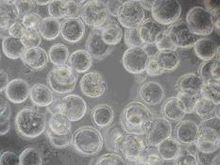Sf-9 cells
Sf-9 is an immortalized insect - cell line from ovary - cells of Spodoptera frugiperda , a Nachtfalterart to the family of cutworms (Noctuidae) and to the order of the butterflies is one (Lepidoptera). This is used in biotechnology for the production of recombinant proteins .
cultivation
The Sf-9 cells are robust cells that are not very sensitive to shear stress and that grow adherently in cell cultures and in suspension . Their optimal cultivation temperature is around 27 ° C, with an optimal pH value of 6.2. They can be cultivated well in serum-free media, with an amino acid concentration that is about ten times higher than that of comparable media for mammalian cells.
use
Sf-9 (and related cells such as Sf-21) and Tn-5 (more precisely BTI-Tn-5B1-4, also High Five ® ) from Trichoplusia ni are nowadays used almost exclusively for the production of recombinant proteins by insect cell culture used. This makes use of the fact that these cells can easily be infected with baculoviruses (e.g. AcMNPV). The genome of the virus can be modified relatively easily so that it codes for the desired protein (usually under the control of the viral polyhedrin promoter). After infection of the Sf-9 cells with these viruses, the cells are stimulated to synthesize large amounts of the recombinant protein. Since the modified viruses are completely harmless to higher eukaryotes, this work can be carried out with relatively little safety precautions. Further advantages over other expression systems are:
- Insect cells are compared to z. B. HeLa cells are relatively cheap and very easy to cultivate
- Unlike E. coli and yeast, they perform almost all post-translational protein modifications, i.e. H. the proteins obtained are very similar to those of humans
- As a result, the proteins almost always have a very good solubility (in contrast to recombinant proteins from E. coli , which are often insoluble because this bacterium cannot carry out any post-translational modifications comparable to humans and still only has a very simple chaperone system)
history
Sf-9 cells are derived from the ovarian tissue of Spodoptera frugiperda taken during the pupal stage. This was done in 1977 via an intermediate cultivation of the IPLB-Sf21AE cell line. From a clone , i.e. H. Sf-9 cells were isolated from the descendants of a cell IPLB-Sf21AE.
In 1991, WF Hink from Ohio State University developed a serum-free medium with which Sf-9 cells can be cultivated and in which the production of recombinant proteins succeeds just as well as in cultures that are grown with the usual serum-containing medium.
Individual evidence
- ↑ Vaughn, JL et al. (1977): The establishment of two cell lines from the insect Spodoptera frugiperda (Lepidoptera; Noctuidae). In: In Vitro. Vol. 13, pp. 213-217. PMID 68913 .
- ↑ Hink, WF (1991): A serum-free medium for the culture of insect cells and production of recombinant proteins. In: In Vitro Cell. Dev. Biol. Vol. 27, pp. 397-401. PMID 1906456

